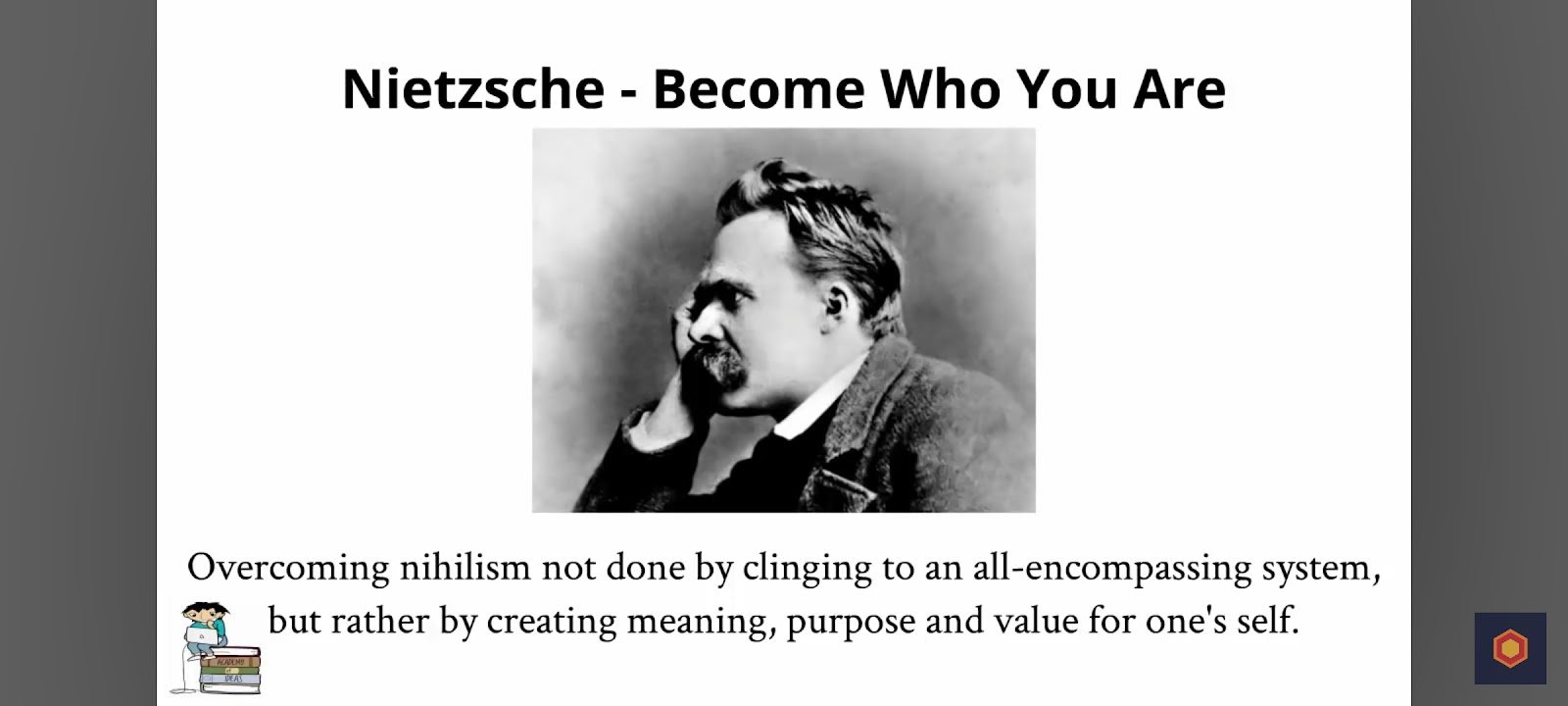Existentialism
This blog assignment is a result of engaging with the flipped learning exercise focused on Existentialism.
What's Flipped Learning?
Flipped learning is when you learn the lesson at home through videos or readings, and then use class time to discuss and work on exercises with the teacher.
Notions I find appealing:
Video 1.
In the first video, what caught my attention was the notion that existentialism places great importance on individuality, passion, and freedom. It's akin to a triangular connection where these three elements intersect, and existentialism serves as a linchpin in orchestrating their dynamic interplay. This emphasizes how personal identity, deep-seated enthusiasm, and the ability to choose independently form a cohesive and intricate relationship within the realm of existentialism.
Video 2.
Existentialism suggests that life doesn't come with a ready-made purpose, so figuring out what gives life meaning becomes a crucial quest. Once someone recognizes the absurdity of life, they face a crossroads with only two options: embracing "Hope" or contemplating the weighty decision of "Suicide."
Video 3.
The video talks about how we feel about things. It says that wanting to escape means you think something isn't necessary. Escaping from life's problems might make you feel like life isn't worth it, but the video suggests finding specific answers to your problems is important. If you can't find solutions, it feels strange, and you keep struggling. The advice is to stay calm and make decisions. Dealing with life's challenges while having faith can help you get through tough times. The video also mentions a "leap," which is inspired by different ways of looking at religion and life.
Video 4.
Dadaism, started during World War 1, wanted change and new art. Nihilism says life is meaningless, so do what you want. Existentialism, from World War 2, is about your right to live freely. Hugo Ball liked Dadaism for freedom, and R. Mutt made cool art from those ideas.
Video 5.
The video talks about existentialism, focusing on anxiety, despair, and absurdity in life. Anxiety, linked to the idea of God being truth, affects your thoughts, but you have the choice to stay calm and work towards success. Nietzsche's message is to become who you are, believe in yourself, and always make your own choices. Existentialism, different from nihilism, is a response to the emptiness in life and thinking.
Video 6.
I find it intriguing that there's no escape from life's absurdities while we're alive. According to Albert Camus's The Myth of Sisyphus, the only way to respond to these absurdities is through rebellion.
Video 7.
In the seventh video, I really liked these ideas.
They talked about the human condition, asking questions like "Why am I here?" and "What does it mean to be human?" These questions make life seem a bit absurd, rejecting big, all-encompassing systems.They also said we should look at the human condition from a human perspective, not a divine one.Nietzsche's idea of "becoming who you are" means creating your own meanings, purpose, and value in life.
Video 8.
In this video, they're talking about existential philosophy and Nietzsche's idea of Ubermacht, which is like a 'superman.' It means you have the power to shape your own life and give it meaning, just like Superman can do anything.
Video 9.
I really like what Eric Dodson shared in video 9. He compared Existentialism to everyday life, focusing on ideas, creativity, and sensitivity. Dodson talks about honesty, straightforwardness, and the freedom to make choices in existentialism, even acknowledging the darker sides of life. He sees it as a reflection of who we are and a chance to make choices based on our own values and rights.
Video 10.
It's interesting how most people see "absurdity" as something funny, but for those into absurdism, it means something more serious and meaningful.
My Favorite Video Among All :
I really enjoyed Video 7, where they dive into Existentialism. The discussion at 01:20 about its origins and pioneers, especially the impact of World Wars at 01:38, was insightful. They touch on common questions like "Why am I here?" at 03:02, leading to various philosophical ideas. The video explores the contradiction between religious beliefs and individuality around creating one's meaning at 06:20, even bringing in Aristotle's views at 08:00. What stood out for me was the clarification on the difference between Nihilism and Existentialism at 10:44. Nietzsche's quote, "Nihilism is a disease" and "Become what you are," was nicely explained at 11:15. The video also emphasizes the core idea of Existentialism – that we can create our own subjective meaning.
Learning outcome -
This activity increased my understanding of Existentialism, especially with visuals, making concepts clearer. The videos covered diverse areas, providing deeper knowledge and connecting movements like Nihilism, Essentialism, and Dadaism. Overall, the flipped learning approach helped me grasp existential philosophy better.
Questions -
1. (Video 7 10:17) Sartre says that existence precedes essence”. But if we look at legendary people from history, (including Sartre) can we not say that their essence has preceded their existence, since the ideas they left behind are still valued?
2. (Video 7 11:07) Here it is said that existentialists believed in creating their own meaning of life and Nihilists believed that life had no meaning. So is nihilism similar to absurdism?
3. (Video 8) Nietzsche says that an Ubermensche follows only the rules he wants. Wouldn’t this lead to chaos in society? What is the guarantee that people will act morally?
4. (video 9 2:14) How is existentialism appealing to the heart? What is the poetic side referred here?
5. Why is Sartre considering Freedom a type of condemnation? Is it not better to be free?






Comments
Post a Comment